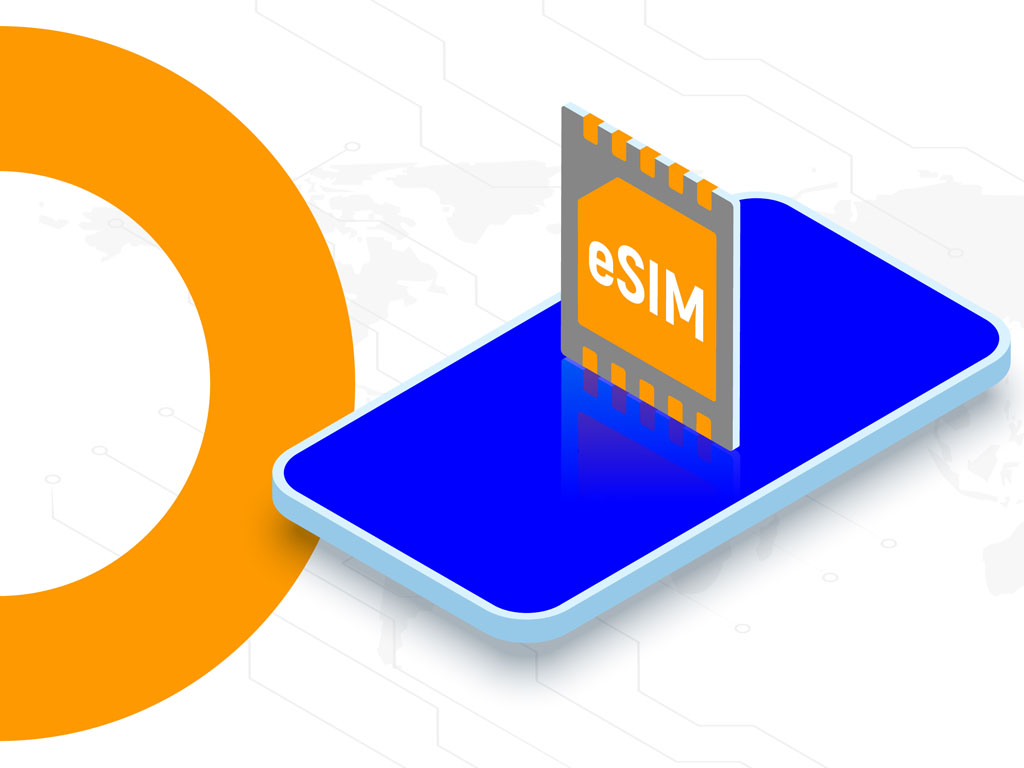Revolutionary eSIM Adoption: Igniting its Power and Empowering Telcos to Lead the Charge
17th April, 2023
Author: Alin Bucsai, Key Account Manager, Europe & Africa
Category: Industries

Say goodbye to the hassle of searching for a local carrier and buying a physical SIM card every time you travel abroad. With the revolutionary eSIM technology, staying connected is as simple as tapping a few buttons on your phone, as long as you have an internet connection.
If you’ve been out of the loop, let us introduce you to eSIMs. These digital SIM cards are integrated directly into devices, eliminating the need for a physical card to connect to a cellular network. This game-changing technology allows you to effortlessly switch between carriers and plans without the hassle of obtaining a new SIM card each time.
Sounds convenient, right?
However, despite the undeniable benefits, eSIM adoption on a global scale has been slower than anticipated. In this blog post, we delve into the current state of eSIMs in global markets and discuss how telecommunication companies can play a pivotal role in driving their widespread usage.
The Historical Journey of SIM Cards
The SIM card, initially introduced by German company Giesecke+Devrient in 1991, marked a significant milestone in mobile technology. This Subscriber Identity Module, roughly the size of a credit card, paved the way for further advancements. In 1996, the mini SIM was introduced, followed by the micro SIM in 2010. A few years later, the nano-SIM took center stage, captivating users with its compact design.
In the 2010s, eSIMs emerged as a game-changer, beginning with the Samsung Gear S2 Smartwatch as the pioneer device supporting this innovative technology. Let’s embark on a journey through the evolution of eSIMs, highlighting key milestones that have shaped their development to this day:
- 2017: Apple shook the industry with the launch of the Apple Watch Series 3, which propelled eSIM adoption to new heights. Since then, Apple has remained at the forefront of eSIM advancements. In the same year, the Google Pixel 2 also debuted, featuring Google Fi eSIM technology.
- 2018: Microsoft made its foray into the world of eSIMs with the Surface Pro LTE. Additionally, the Google Pixel 3 and Pixel 3 XL hit the market, offering eSIM support. However, Apple stole the spotlight by introducing three eSIM-enabled devices: the iPhone XS, iPhone XS Max, and iPhone XR.
- 2019: Google continued to contribute to the eSIM revolution with the launch of the Pixel 3 XL and Pixel 3A. Samsung also joined the movement by unveiling the Samsung Galaxy Fold with eSIM support.
- 2020: Motorola entered the eSIM arena with the Razr smartphone. Samsung continued its commitment to eSIMs by releasing the Samsung Galaxy Note 20 Ultra, 20+, and 20, all equipped with eSIM capabilities.
- 2022: Apple solidified its position as a leader in eSIM-compatible phones with the highly popular iPhone 14 and iPhone 14 Plus, Pro, and Pro Max models. Samsung also embraced eSIM technology by including eSIM support in all three of its flagship phones: the Ultra 5G, S22+ 5G, and S22.
As we reflect on this timeline, it becomes evident that eSIMs have come a long way, and their presence in the mobile landscape continues to grow. The future holds even more exciting possibilities for this transformative technology.
Understanding The Global Delay In eSIM Adoption
Despite the myriad benefits offered by eSIMs, the global transition to this cutting-edge technology has been slower than anticipated. Surprisingly, even the United States, renowned for its tech advancements, has been sluggish in embracing eSIMs, both among consumers and telecommunication companies.
A key contributing factor to this delayed adoption is the lack of awareness. Many consumers remain unfamiliar with the concept of eSIM technology, creating a significant knowledge gap. Additionally, since eSIMs are still relatively new, some users may find them challenging to navigate. It’s natural for individuals to require a period of adjustment to fully grasp the intricacies of this novel technology and maximize its potential.
Navigating e-SIM Markets: Uncovering Obstacles in Europe, Asia, Middle East, and Africa
Middle East and Africa: Despite the abundance of opportunities for eSIM adoption in this region, particularly in the realm of IoT devices, consumer electronics, and connected cars, progress has not been as swift as expected. The primary obstacles impeding the growth of eSIMs in these markets are a lack of consumer awareness and concerns regarding data security surrounding eSIM technology.
Europe: The slow adoption of eSIMs in Europe can be attributed to the limited promotion by major telecommunications companies and the overall lack of popularity surrounding this technology. Additionally, security concerns have surfaced in the past, creating additional barriers to eSIM adoption within the European market.
Asia: Despite being home to several significant developing markets, Asian consumers have yet to fully embrace eSIMs. The adoption rate has been relatively low, partly due to the failure of Asian telecommunications companies to implement eSIM technology on a broader scale.
US eSIM Market Soaring: Unraveling the Success Amidst Global Comparisons
American companies such as Google and Apple have played a pivotal role in spearheading the promotion of eSIM technology within the United States. Their proactive efforts have yielded significant results, as the eSIM market in the US has experienced substantial growth. Furthermore, companies like Apple expanded their eSIM offerings to include other devices like smartwatches, further fueling the adoption and usage of eSIMs.
Thanks to the concerted promotional efforts and the widespread availability of eSIM-enabled devices, American consumers now possess a comprehensive understanding of the benefits associated with eSIMs. As a result, the US market has outperformed its counterparts in terms of eSIM adoption, positioning itself at the forefront of this technology’s advancement.
The Apple iPhone 14 release has fueled global demand for eSIMs, as Apple’s influence as a market leader in eSIM technology inspires other manufacturers and telcos to prioritize its adoption.
In addition, Google’s Android 13, with its support for Multiple Embedded Profiles (MEP), has facilitated the use of 5G eSIMs in dual sim devices, presenting a significant advancement that will drive eSIM adoption.
These developments have made eSIMs more accessible and appealing to consumers, indicating a promising trajectory for their continued growth and popularity in the future.
Is the Era of eSIMs on the Horizon?
The Apple iPhone 14 release has fueled global demand for eSIMs, as Apple’s influence as a market leader in eSIM technology inspires other manufacturers and telcos to prioritize its adoption.
In addition, Google’s Android 13, with its support for Multiple Embedded Profiles (MEP), has facilitated the use of 5G eSIMs in dual sim devices, presenting a significant advancement that will drive eSIM adoption.
These developments have made eSIMs more accessible and appealing to consumers, indicating a promising trajectory for their continued growth and popularity in the future.
Accelerating eSIM Adoption Worldwide: Strategies for Telcos
Telcos can drive global eSIM adoption through various strategies:
- Offer eSIM support: Telcos should provide eSIM support, allowing customers to utilize eSIMs and enjoy their benefits.
- Educate customers: Telcos should educate customers about eSIM technology through marketing campaigns, informative videos, and other resources to increase awareness and understanding.
- Simplify the process: Telcos can simplify the eSIM activation process by offering clear instructions and guidance, making it easier for customers to adopt and use eSIMs on their devices.
- Incentivize adoption: Telcos can encourage customers to switch to eSIMs by offering incentives such as discounts, free data, or rewards.
- Collaborate with device manufacturers: Telcos can collaborate with device manufacturers to ensure seamless integration of eSIMs into devices and simplify activation processes.
- Environmental impact: telcos can shift towards eSIM-only contracts or prepaid deals to reduce plastic, paper, and cardboard waste associated with physical SIM cards.
Telcos play a crucial role in driving eSIM adoption globally, and by leveraging partnerships with companies like Prepay Nation, eSIM providers can unlock opportunities for growth and expansion.
Prepay Nation, as a global B2B product marketplace for prepaid products, offers access to a vast customer base and telecom operator partnerships worldwide. By collaborating with Prepay Nation, eSIM providers can tap into a thriving market and reach value-conscious customers who actively engage in gifting airtime, data, and utility payments to loved ones abroad.
Contact Prepay Nation today to explore how we can pave the way for your success in the dynamic eSIM industry. Together, we can revolutionize the eSIM landscape and empower customers worldwide with innovative connectivity solutions.

Author
Alin Bucsai, Key Account Manager, Europe & Africa